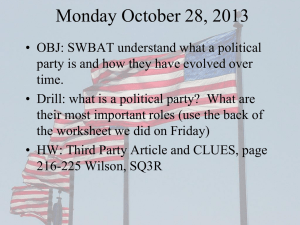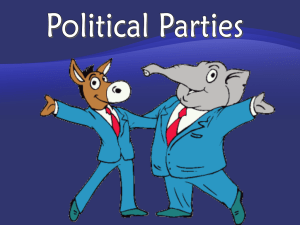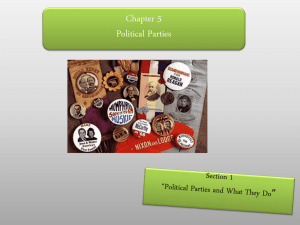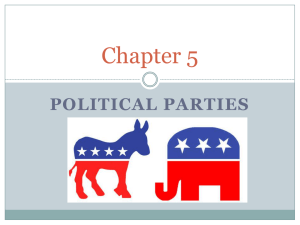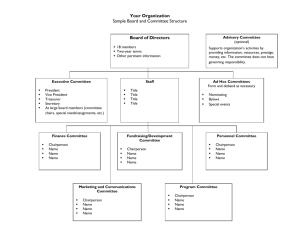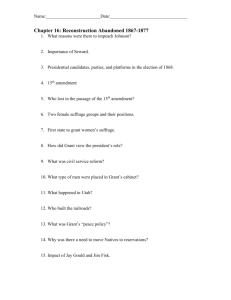AP Government Chapter 9 Notes: Political Parties
advertisement
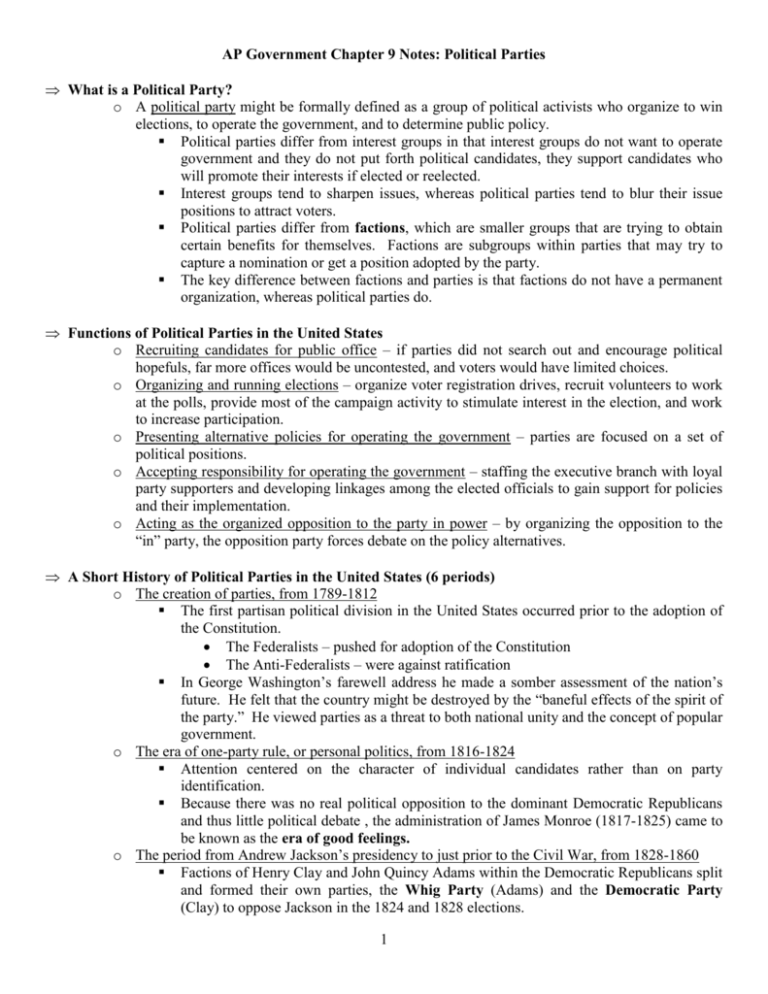
AP Government Chapter 9 Notes: Political Parties What is a Political Party? o A political party might be formally defined as a group of political activists who organize to win elections, to operate the government, and to determine public policy. Political parties differ from interest groups in that interest groups do not want to operate government and they do not put forth political candidates, they support candidates who will promote their interests if elected or reelected. Interest groups tend to sharpen issues, whereas political parties tend to blur their issue positions to attract voters. Political parties differ from factions, which are smaller groups that are trying to obtain certain benefits for themselves. Factions are subgroups within parties that may try to capture a nomination or get a position adopted by the party. The key difference between factions and parties is that factions do not have a permanent organization, whereas political parties do. Functions of Political Parties in the United States o Recruiting candidates for public office – if parties did not search out and encourage political hopefuls, far more offices would be uncontested, and voters would have limited choices. o Organizing and running elections – organize voter registration drives, recruit volunteers to work at the polls, provide most of the campaign activity to stimulate interest in the election, and work to increase participation. o Presenting alternative policies for operating the government – parties are focused on a set of political positions. o Accepting responsibility for operating the government – staffing the executive branch with loyal party supporters and developing linkages among the elected officials to gain support for policies and their implementation. o Acting as the organized opposition to the party in power – by organizing the opposition to the “in” party, the opposition party forces debate on the policy alternatives. A Short History of Political Parties in the United States (6 periods) o The creation of parties, from 1789-1812 The first partisan political division in the United States occurred prior to the adoption of the Constitution. The Federalists – pushed for adoption of the Constitution The Anti-Federalists – were against ratification In George Washington’s farewell address he made a somber assessment of the nation’s future. He felt that the country might be destroyed by the “baneful effects of the spirit of the party.” He viewed parties as a threat to both national unity and the concept of popular government. o The era of one-party rule, or personal politics, from 1816-1824 Attention centered on the character of individual candidates rather than on party identification. Because there was no real political opposition to the dominant Democratic Republicans and thus little political debate , the administration of James Monroe (1817-1825) came to be known as the era of good feelings. o The period from Andrew Jackson’s presidency to just prior to the Civil War, from 1828-1860 Factions of Henry Clay and John Quincy Adams within the Democratic Republicans split and formed their own parties, the Whig Party (Adams) and the Democratic Party (Clay) to oppose Jackson in the 1824 and 1828 elections. 1 That same Democratic Party is now the oldest continuing political party in the Western world. The Whigs were often called the “National Republicans.” o The Whig party became divided over the issue of slavery in the late 1840s. During the 1850s, the Whigs fell apart as a national party. o The post Civil War period, from 1864-1892 The newly formed Republican Party’s (created from various groups that sought to fill the vacuum left by the disintegration of the Whigs) candidate was elected: Abraham Lincoln. It took the label of “Grand Old Party or GOP.” After the end of the Civil War, the South became heavily Democratic (the Solid South) and the North became heavily Republicans. The Republicans’ control was solidified by winning over the urban working-class vote in northern cities. This was an era of Republican dominance. o The progressive period, from 1896-1928 In 1912, a major schism (factional division) occurred in the Republican Party when former Republican president Theodore Roosevelt campaigned for the presidency as a Progressive. There were three significant candidates: Woodrow Wilson (Democrat), William Howard Taft (Republican) and Theodore Roosevelt (Progressive). The Republican split allowed Wilson to win the presidency. The Wilson administration although Democratic, ended up enacting much of the Progressive Party’s platform. Left without any reason for opposition, the Progressive Party collapsed in 1921. Republicans dominated until 1932 when Franklin D. Roosevelt (Democrat)was elected o The modern period, from 1932-present Franklin Roosevelt was elected in 1932, and reelected in 1936, 1940, and 1944. The impact of his successive Democratic administrations and the New Deal that he crafted is still with us today. Roosevelt used his enormous personal appeal to unify Democrats under his leadership, and he established direct communication between the President and the public through his radio “fireside chats.” 1952-1960 the Republicans were in control once more 1960-1968 the Democrats were in control 1968-1976 the Republicans were in control 1976-1980 the Democrats were in control 1980-1992 the Republicans were in control The election of George H.W. Bush in 1988 may have signaled the beginning of a true era of divided government (one party controls the presidency and the other controls Congress). The Three Faces of a Party o Party-in-the-electorate – this phase refers to all those individuals who claim an attachment to the political party. It is the large number of Americans who feel some loyalty to the party or who use partisanship as a cue to decide who will earn their vote. o Party Organization – provides the structural framework for the political party by recruiting volunteers to become party leaders; identifying potential candidates; and organizing caucuses, conventions, and election campaigns for its candidates. It is the party organization and its active workers that keeps the party functioning between elections, as well as make sure that the party puts forth electable candidates and clear positions in the elections. 2 When individuals accept paid employment for a political party, they are considered party professionals: o Campaign consultants o Fundraisers o Local, state, and national executives o National staff members If the party-in-the-electorate declines in numbers and loyalty, the party organization must try to find a strategy to rebuild the grassroots following. o Party-in-government – includes those who are elected and appointed officials who identify with a political party. Tiers to a political party are essential to the functioning of government and the operation of the political process in the United States. If the party organization and the party-in-government are in conflict, the party-in-theelectorate is likely to look for other party leadership to articulate its preferences. Party Organization o In theory, each of the American political parties has a standard, pyramid-shaped organization. The pyramid, however, does not accurately reflect the relative power and strengths of the individual parts of the party organization. o In reality, the formal structure of the political parties resembles a layer cake with autonomous (independent) strata more than it does a pyramid. Each “layer” of an American political party is representative of a level of government, from local to national. Although there are linkages between the layers, each is fairly independent of the others in terms of financing, supporters, nominations, and platform. No one level of the party has real control over any other level. National Chairperson and National Committee National Convention and Delegates State Chairperson and State Committee County Chairperson and County Committee Ward or Township Chairperson and Ward or Township Committee Precinct Chairperson and Precinct Committee 3 o The National Party Organization – each party has a national organization. The most institutional part of which is the national convention: National convention is held every 4 years. It is used to nominate the presidential and vice presidential candidates. In addition, the party platform (the party’s position on issues) is written, ratified, and revised at the national convention. Each of the parties formally chooses a national standing committee (national committee), elected by the individual state parties. National Committee is established to direct and coordinate party activities during the following four years. One of its jobs is to ratify the presidential nominee’s choice of a national chairperson, who in principle acts as the spokesperson for the party. Basically, the national chairperson and national committee simply plan the next campaign and the next convention, obtain financial contributions, and publicize the national party. Each party picks a national chairperson. In general, the party’s presidential candidate chooses the national chairperson (if that candidate loses, however, the chairperson is often changed). Major responsibility of the chairperson is the management of the national election campaign. Chairperson establishes a national headquarters, raise campaign funds and distribute them to state parties and to candidates, and appear I the media as the party spokesperson. The national chairperson, along with the national committee, attempts basically to maintain some sort of liaison among the different levels of the party organization. o The State Party Organization – there are 50 states in the union, plus territories and the District of Columbia, and an equal number of party organizations for each major party. Each state party has a chairperson, a committee, and a number of local organizations State central committee is usually composed of those members who represent congressional districts, state legislative districts, or counties, has the responsibility for carrying out the policy decisions of the party’s state convention, and in some states the state committees wil direct the state chairperson with respect to policymaking. Like the national committee, the state central committee has control over the use of campaign funds during political campaigns. State parties are also important in national politics because of the unit rule, which awards electoral votes in presidential elections as an indivisible bloc (except in Maine and Nebraska). o Local Party Machinery: The Grassroots – the lowest of the party machinery is the local organizations supported by district leaders, precinct or ward captains, and party workers. Much of the work is coordinated by county committees and their chairpersons. At the end of the 19th century, the institution of patronage held the local organization together. For immigrants and the poor, the political machine often furnished important services and protections. City machines are now dead, mostly because their function of providing social services (and reaping the reward of votes) has been taken over by state and national agencies. This trend began in the 1930s as the result of New Deal legislation. 4 Local political organizations still can contribute a great deal to local election campaigns. These organizations are able to provide the foot soldiers of politics – individuals who pass out literature ad get out the vote on Election Day, which can be crucial in local elections. Local party organizations are also important vehicles for recruiting young adults into political work, because political involvement at the local level offers activities many opportunities to gain experience. The Party and Its Members – there are significant differences between the parties, both in the characteristics of their members and in their platforms. o Differences between the parties – although Democrats and Republicans are not divided along religious or class lines to the extent than some European parties are, certain social groups are more likely to identify with each party. Democrats – since the New Deal, the Democratic Party has appealed to the more disadvantage groups in society, African Americans, unions, Jewish voters, and individuals who have less than a high school education. More women than men tend to identify themselves as Democrats. Minorities, the working class, and various ethnic groups (see chart on page 290). In general, Democratic identifiers are more likely to approve of social welfare spending, to support government regulation of business, to approve of measures to improve the situation of minorities, and to support assistance to the elderly with their medical expenses. Republicans – draw more of their support from college graduates, upper-income families, and professionals or business persons. Republicans are more supportive of the private marketplace, and many feel that the federal government should be involved in fewer social programs (see chart on page 290). The Party-In-Government – once the election is over, the focus of party activity shifts from getting out the vote to organizing and controlling the government. o Party membership plays an important role in the day-to-day operations of Congress, with partisanship determining everything from office space to committee assignments and power on Capitol Hill. For the President, the political party furnishes the pool of qualified applicants for political appointments to run the government. All of these party appointments suggest that the wining political party, whether at the national, state, or local level, has a great deal of control in the American system. Most Americans prefer a divided government, with the executive and legislative branches controlled by different parties (like checks and balances). Why Do We Have A Two-Party System? o The historical foundations of the system – the first two opposing groups in U.S. politics was the Federalists and the Anti-Federalists. Federalists represented those with commercial interests including merchants, ship owners, and manufacturers. The Federalists supported the principle of a strong national government. Anti-Federalists (later became the Democratic Republicans) represented artisans and farmers. They strongly supported states’ rights. These interests were also fairly well split along geographic lines, with the Federalists dominant in the North and the Democratic Republicans dominant in the South. 5 o o o o Civil War to the 1920s has been called one of sectional politics – North versus South. The split was ideological (over the issue of slavery), as well as economic (the Northeast’s industrial interests versus the agricultural interests of the South). Today, sectional politics has largely given way to national politics (or can also be described as class politics), which focuses on the concerns of the nation as a whole. The self-perpetuation of the parties – most children identify with the political party of their parents. Relatively few are taught to think of themselves as Libertarians or Socialists, or even independents. This generates a built-in mechanism to perpetuate a two-party system. The commonality of views among Americans (political culture of the U.S.) Most Americans want continuing material prosperity. They also believe that this goal should be achieved through individual, rather than collective, initiative. Private property is considered a basic American value, and the ability to acquire and use it the way one wishes commonly is regarded as a basic American right. We have had a basic consensus about our political system and the two major parties is that we have managed largely to separate religion from politics. The major division in American politics has been economic Not only does the political culture support the two-party system, but also the parties themselves are adept at making the necessary shifts in their platforms or electoral appeal to gain new members. The winner-take-all electoral system – the outcome of elections is based on the plurality (the most votes, not necessarily the majority), winner-take-all principle. The winner-take-all system also operates in the Electoral College – whoever gets the most votes in a state, gets all the electoral votes in that state. Minor parties have a difficult time competing under such a system, even though they may influence the final outcome of the election. Voters know that minor parties cannot succeed, they often will not vote for minorparty candidates, even if the voters are ideologically in tune with them Not all the states use the plurality, winner-take-all electoral system. Some hold off runoff elections until a candidate obtains at least one vote over 50% of the votes. State and federal laws favoring the two-party system In some states, the established major parties need to gather fewer signatures to place their candidate on the ballot than minor parties or independent candidates do. The criterion for determining how many signatures will be required is often based on the total party vote in the last general election. At the national level, minor parties face different obstacles. All of the rules and procedures of both houses of Congress divide committee seats, staff members, and other privileges on the basis of party membership The Federal Election Commission (FEC) rules for campaign financing also place restrictions on minor-party candidates. Such candidates are not eligible for federal matching funds in either the primary or the general election. The Role of Minor Parties in U.S. Political History o Historically Important Minor Parties The Socialist Labor Party, started in 1877 The Socialist Party, founded in 1901 by Eugene Debs Owed most of its success to the corruption of big-city machines and to antiwar sentiment. 6 The Communist Party, started in 1919 as the radical left wing that split from the Socialist Party. The Socialist Workers’ Party, formerly a Trotskyite group, started in 1938 The Libertarian Party, formed in 1972 and still an important minor party Supports a laissez-faire capitalist economic program, combined with a hands-off policy on regulating matters of moral conduct. The Reform Party, founded in 1996 by H. Ross Perot Seeks to reform the political process and reduce the size of government. o Splinter Minor Parties – the most successful minor parties have been those that split from major parties. The most famous splinter party was the Bull Moose Progressive Party, which split from the Republican Party in 1912 over the candidate chosen to run for president. Since the vote was split between the Republican Party and the Bull Moose Progressive Party, it allowed the Democrat candidate to be elected. Among the Democrats, there has been three splinter third parties since the late 1940s : the Dixiecrat (State’s rights) Party of 1948; Henry Wallace’s Progressive Party of 1948; and the American Independent Party supporting George Wallace in 1968. The American Independent Party emphasized mostly racial issues, and to a lesser extent, foreign policy. o Other Minor Parties Numerous minor parties have come together around specific issues or aims. Free Soil Party, active from 1848-1852, was dedicated to preventing the spread of slavery Prohibition Party -- the goal of this party started in 1869, which was to ban the sale of liquor. Some minor parties have had specific economic interests as their reason for being. The Greenbacks – lasted from 1876-1884. It was one of the most prominent farmer-labor parties that favored government intervention in the economy. Populist Party – lasted from 1892-1908. Farmers were the backbone of this party, and agrarian reform was its goal. o The Impact of Minor Parties Sometimes the third-party issues were taken over some years later by a major party. Can have a serious impact on the outcome of an election – splitting the votes The Uncertain Future of Party Identification – ties to the two major parties has weakened in the last three decades, but also voters are less willing to vote a straight ticket – that is to vote for all the candidates of one party. The percentage of voters who engage in ticket splitting has increased from 12% in 1952 to more than 38% in the presidential election of 1996. This trend, along with the increase in the number of voters who call themselves independents suggests that parties have lost much of their hold on the loyalty of the voters. Political Parties: Issues for the 21st Century o Relationship to the voters: what can the parties offer to individuals to induce them to become loyal party members? o Political parties have been weakened by the growing independence of political candidates and the ability of those candidates to raise their own funds and to run their own campaigns o Do the political parties actually stand for different positions on the issues? 7


